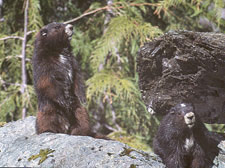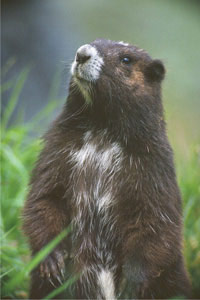Struggling on the brink of extinction since 1994, Canada’s most endangered animal made a gain of almost twenty marmots in 2002 from a population of less than 70 animals to almost 90.
“Last years sad news, two of our breeding adults were killed on Mount Washington by wolves, was softened by news of two successful litters there, plus three additional litters on “P”, Heather and Green mountains all located just east of Nanaimo. Our captive population was busy too. We had 5 litters in captivity at our partner facilities, the Calgary and Toronto zoos and Mountain View Farms in Langley, totaling 13 pups”, said Viki Wilson, Executive Director of the Marmot Recovery Foundation. Now begins an even harder task for the Foundation – reintroduction – or rebuilding the wild population by introducing captive bred marmots into the wild colonies.
 “We’ve finally succeeded in increasing the total number of animals but there are still enormous challenges ahead of us. Introduction of captive bred marmots to wild habitat has not yet been tested although we’ve had success with two translocations. Four isolated wild marmots were “paired up” by moving one male and one female and both pairs produced off spring this year. That’s a pretty good indicator that it should work and a huge win for the wild population,” Viki went on to say.
“We’ve finally succeeded in increasing the total number of animals but there are still enormous challenges ahead of us. Introduction of captive bred marmots to wild habitat has not yet been tested although we’ve had success with two translocations. Four isolated wild marmots were “paired up” by moving one male and one female and both pairs produced off spring this year. That’s a pretty good indicator that it should work and a huge win for the wild population,” Viki went on to say.
Mount Washington continues to act as the hub for VIM research and recovery efforts as well as supporting the largest single natural colony of wild Vancouver Island marmots on the island – half of the total wild population. The dedicated marmot recovery center completed in 2001 on Mount Washington serves as a “half way house” for marmots bred off island, quarantining and acclimatizing them before they are released into the wild colonies, as well as acting as a breeding and research center.

Field work on Mount Washington is aimed at protecting and increasing the wild Marmot population.
Called the “Tony Barrett Mount Washington Marmot Recovery Center”, it sits on land donated to the project by the Mount Washington Alpine Resort who also hosts a public marmot interpretive center to teach the public about the plight of the Vancouver Island marmot and the recovery efforts to save it. Unfortunately, the Recovery Center itself remains off-limits to the public to prevent habituation of the animals to humans and to avoid risk of disease.
“When you’re down to less than twenty breeding females every animal is precious – you can’t be too cautious. I’m just grateful for the help we receive from so many sources. It restores your faith to know that Canadians are serious enough about their natural legacy to prevent the extinction of this amazing animal. After all, they’re not found anywhere else in the world. If we don’t succeed in rescuing them, that’s it”.

Redsonia & Spargirl enjoy an afternoon in
the sun.

The Marmot’s own cover girl…Mom #2
Photos: Andrew Bryant Services
For more information about the rare Vancouver Island marmot visit their website at marmots.org
